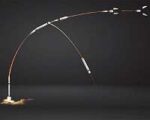France is exploring a new operational role for its upgraded Mirage 2000D RMV fighters — countering unmanned aerial threats. Following recent deployments over the Red Sea to protect commercial shipping from Houthi drone and missile attacks, French defense planners are evaluating whether the legacy strike aircraft can be adapted into a cost-effective counter-UAS (C-UAS) interceptor platform.
Red Sea Combat Experience Shapes New Mission Profile
Since late 2023, French Mirage 2000Ds have been deployed to Djibouti and Jordan in support of Operation Aspides — the EU-led maritime security mission responding to persistent drone and missile attacks by Yemen’s Houthi rebels on commercial vessels in the Red Sea. Operating alongside U.S. Navy assets and other coalition forces, these aircraft have provided air cover for naval convoys and conducted armed reconnaissance missions.
According to statements from French defense officials and industry sources cited by outlets such as Opex360 and Forces Operations Blog (FOB), the Mirage 2000Ds demonstrated high availability rates during these missions — reportedly flying up to three sorties per day with minimal maintenance downtime. More significantly, their performance prompted renewed interest in using them as interceptors against slow-moving or medium-altitude drones that might evade traditional ground-based air defenses or require more agile airborne response.
Upgraded Capabilities Under RMV Standard
The Mirage 2000D RMV (Rénovation Mi-Vie) standard represents a substantial mid-life upgrade for France’s fleet of legacy strike fighters. Originally designed as nuclear-capable precision bombers under France’s Force de Frappe doctrine, these twin-seat aircraft have received avionics modernization and expanded multirole capabilities under an ongoing retrofit program led by Dassault Aviation.
Key upgrades under the RMV package include:
- Integration of MBDA’s MICA IR/EM air-to-air missiles (replacing older Magic II/530 missiles)
- Addition of Thales’ Talios targeting pod for ISR and laser designation
- New digital cockpit displays compatible with night vision goggles (NVG)
- Improved self-protection suite including radar warning receivers (RWR) and chaff/flare dispensers
The inclusion of MICA missiles — particularly the IR variant with imaging infrared seekers — significantly enhances the aircraft’s ability to engage small aerial targets such as drones at short to medium ranges. Combined with Talios’ high-resolution electro-optical/infrared sensors for visual identification and tracking, this makes the Mirage 2000D RMV a potentially viable C-UAS platform without requiring major structural changes.
A Cost-Efficient Complement to Rafale Fleet?
With France prioritizing its Rafale F4 program for high-end air superiority roles and export commitments growing (notably to India, UAE, Egypt), repurposing existing Mirage 2000Ds for niche missions like counter-drone interception may offer strategic value at lower cost. As of early 2024, around two dozen Mirage 2000Ds are slated to remain in service until at least 2035 following their RMV upgrades.
This approach would mirror trends seen in other NATO countries adapting older platforms for secondary roles amid growing drone threats. For example:
- The UK has explored using Hawk trainers equipped with ASRAAMs for low-cost air policing or C-UAS tasks
- The U.S. Air Force has tested older F-16s with advanced sensors against Group I–III UAVs
French officials have not confirmed any formal doctrine change yet but acknowledge that lessons from Operation Aspides are being fed into capability planning discussions within both the Armée de l’Air et de l’Espace (AAE) and Direction Générale de l’Armement (DGA).
Tactical Implications: Intercepting Drones in Complex Environments
The use case under evaluation involves deploying Mirage 2000Ds either from forward bases or carrier decks (via Charles de Gaulle) to intercept drones operating beyond line-of-sight from naval vessels or ground-based radars. This would fill a critical gap in layered defense architectures where SHORAD systems like Crotale NG or Mistral cannot reach.
Drones used by non-state actors such as Yemen’s Houthis often fly low-and-slow profiles using commercial GPS navigation. While some can be jammed electronically or shot down by shipboard guns like France’s RapidFire system or U.S. Phalanx CIWS, others may require kinetic interception at standoff distances beyond effective range of those systems.
The combination of Talios pod imagery with MICA IR guidance could allow visual ID followed by precision engagement without excessive collateral risk — especially important near civilian shipping lanes. However, limitations remain:
- No onboard AESA radar limits detection range vs stealthy drones
- Lack of AI-assisted target recognition compared to newer platforms like Rafale F4+
Industry Perspective: Dassault’s Strategic Positioning
Dassault Aviation has remained tight-lipped on specific C-UAS adaptations but stands to benefit if the role is formalized. The company has invested heavily in sustaining legacy fleets through modular upgrades while focusing future development on FCAS (Future Combat Air System).
If France greenlights dedicated funding lines for C-UAS adaptation of Mirage platforms — potentially under NATO cooperative frameworks or European Defence Fund programs — Dassault could secure additional support contracts through mid-2030s while preserving domestic aerospace jobs.
This also aligns with broader European efforts to field scalable responses to asymmetric aerial threats without relying solely on high-end fifth-gen fighters or expensive GBAD systems like SAMP/T NG.
Outlook: From Experimentation to Doctrine?
No official program name or IOC timeline has been announced yet regarding a dedicated counter-drone role for Mirage 2000D RMVs. However, signs point toward increasing doctrinal interest within AAE leadership circles based on operational feedback loops from Red Sea missions.
If adopted formally, this would mark one of Europe’s first examples of re-tasking legacy fourth-generation strike aircraft into specialized anti-drone roles — offering insights into how NATO air forces might extend platform utility amid evolving threat landscapes dominated by UAV proliferation.










